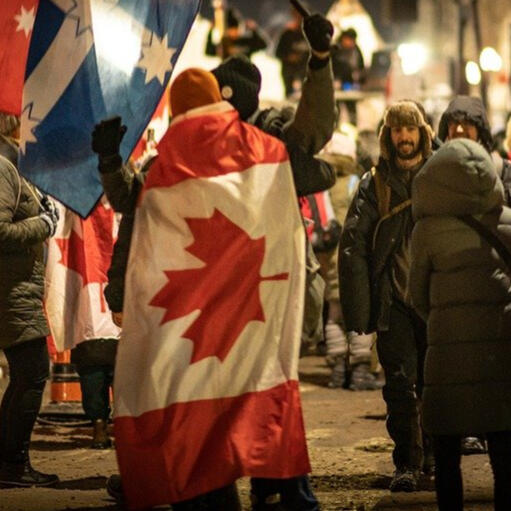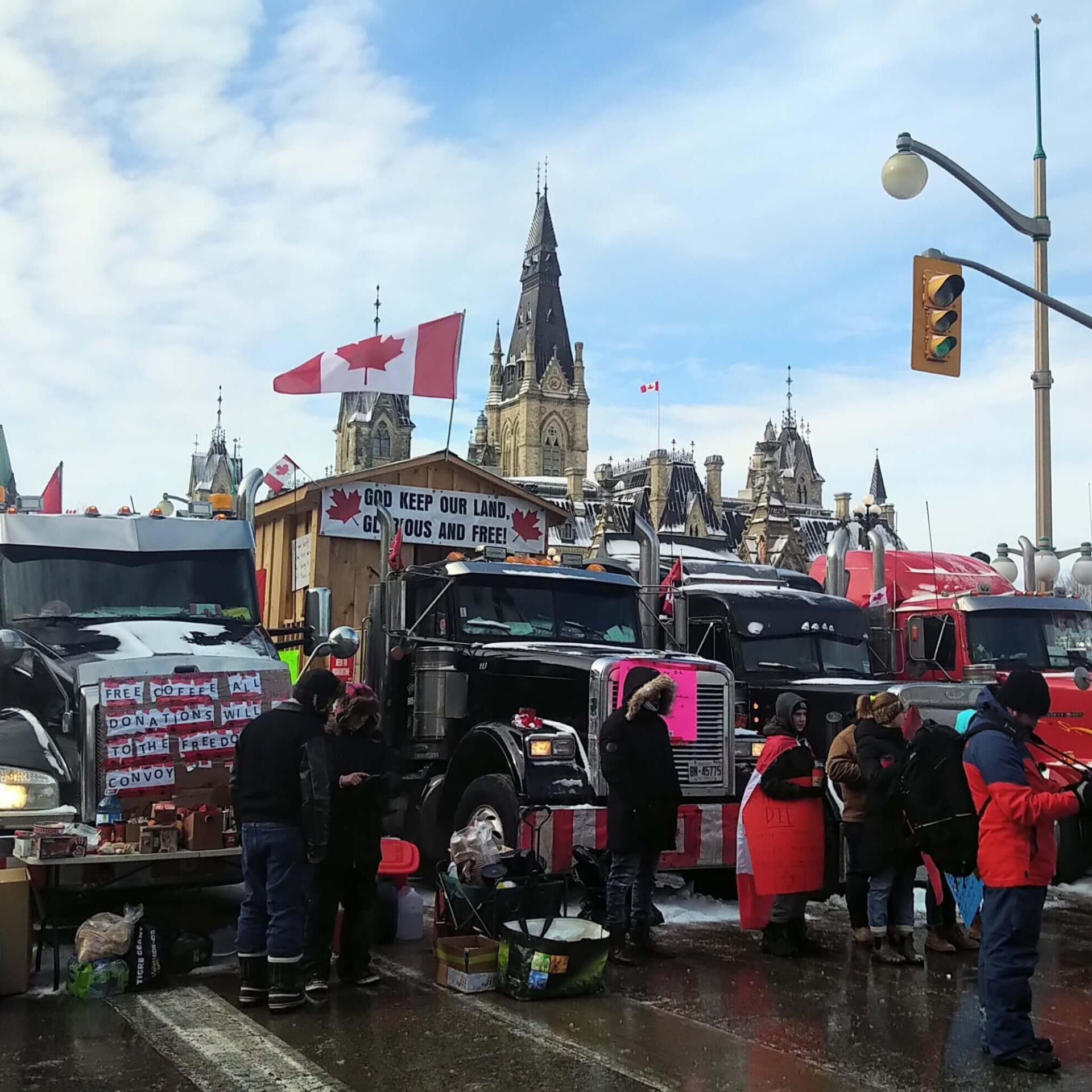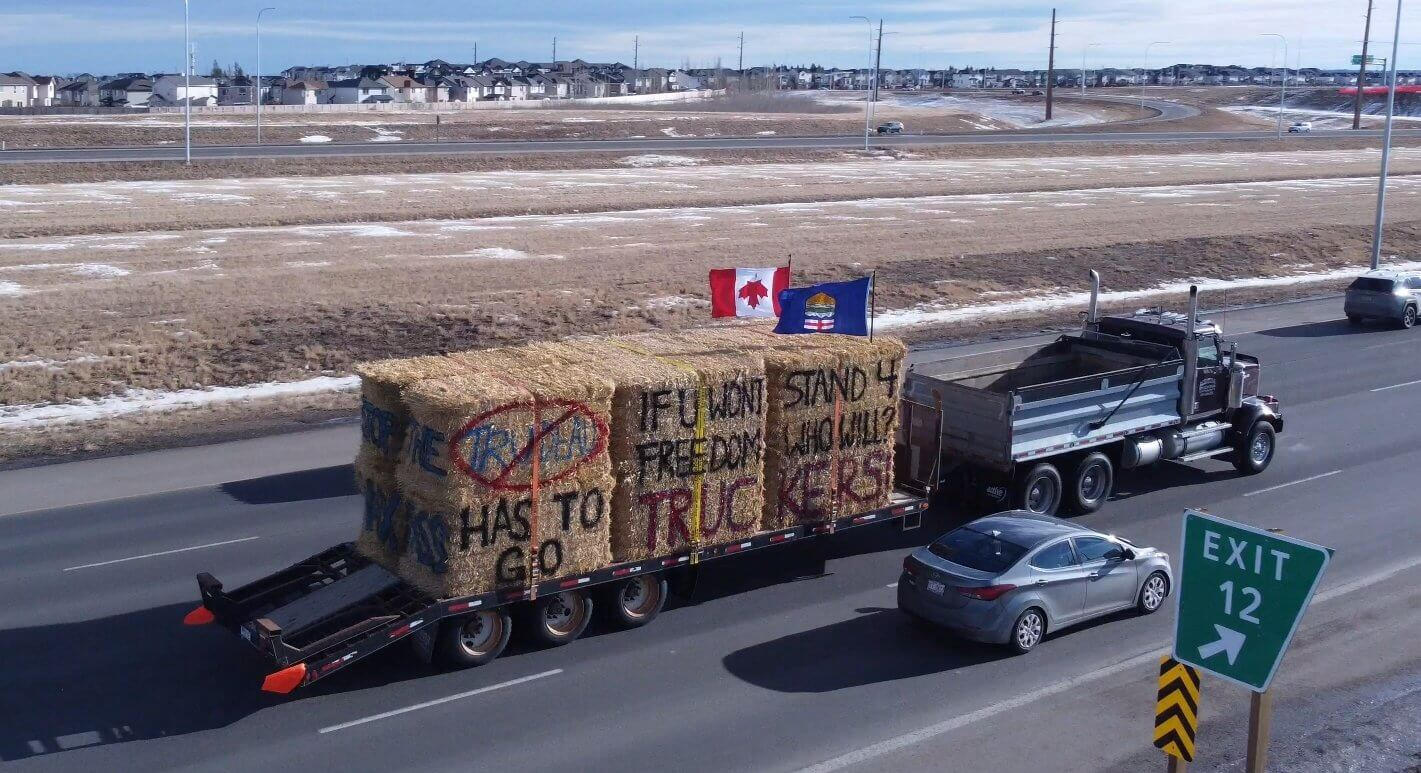
The Canadian Trucker "Freedom Convoy" protest explained
Last updated: Feb 28, 2022
What was the Canadian trucker protest and blockade about?
The Freedom Convoy was a series of protests across Canada, which culminated in the occupation of downtown Ottawa from January 28, 2022 until February 18th, 2022.
At its peak, "about 3,000 trucks and more than 15,000 protesters converge on downtown Ottawa, accompanied by the ongoing cacophony of air horns." (Source]
Broadly, protesters were demanding that the federal government eliminate all COVID-19 mandates and restrictions.
How did the Canadian Freedom Convoy begin?
After initially announcing it on November 19, 2021, the Government of Canada required truck drivers crossing the land border from the US to Canada to be vaccinated by January 15, 2022. (Source)
On January 14th, Tamara Lich and B.J. Dichter created a GoFundMe called "Freedom Convoy 2022." The initial announcement read:
"To our Fellow Canadians, the time for political over reach is over. Our current government is implementing rules and mandates that are destroying the foundation of our businesses, industries and livelihoods. Canadians have been integral to the fabric of humanity in many ways that have shaped the planet.
We are a peaceful country that has helped protect nations across the globe from tyrannical governments who oppressed their people, and now it seems it is happening here. We are taking our fight to the doorsteps of our Federal Government and demanding that they cease all mandates against its people. Small businesses are being destroyed, homes are being destroyed, and people are being mistreated and denied fundamental necessities to survive. It's our duty as Canadians to put an end to this mandates. It is imperative that this happens because if we don't our country will no longer be the country we have come to love. We are doing this for our future Generations and to regain our lives back.
We are asking for Donations to help with the costs of fuel first, and hopefully food and lodgings to help ease the pressures of this arduous task.
It's a small price to pay for our freedoms. We thank you all for your Donations and know that you are helping reshape this once beautiful country back to the way it was."
The following day (Jan. 15), a Facebook post announced the "Freedom Convoy 2022." In that statement they stated:
"On January 15th, a small team of Alberta truckers, their family members and friends, came to the decision that the Government of Canada has crossed a line with implementing Covid-19 vaccine passports and vaccine mandates."
On January 22, 2022, the United States implemented it's proof-of-vaccine requirement for truck drivers crossing the land border from Canada into the US. (Source)
Protesters from western and eastern Canada begin traveling to Ottawa on January 24.
During the trek to Ottawa, many convoy supporters say that upwards of "50,000" trucks were on their way.
Police in Ottawa originally anticipated between 1,000 and 2,000 demonstrators.
But by Saturday, Jan. 29th, "about 3,000 trucks and more than 15,000 protesters converged on downtown Ottawa, accompanied by the ongoing cacophony of air horns." (Source)
Why were the police slow to respond to the protest?
As early as Sunday, January 30, 2022, police in Ottawa were noticing "multiple cases of disruptive, inappropriate and threatening behaviour from demonstrators." However, police restrained themselves from enforcement, hoping that protesters would leave on their own:
"Police have avoided ticketing and towing vehicle so as not to instigate confrontations with demonstrators. Still, confrontations and the need for de-escalation has regularly been required."
How did the protest affect Ottawa residents and businesses?
By Sunday afternoon, police were receiving multiple complaints from Ottawa residents: "Police and City staff are very aware of the complaints relating to parking, idling, noisemaking and other inappropriate behaviour."
On Monday, Chief Sloly was clear that the protest was already having a negative effect on residents and businesses:
I would like to recognize those people who live, work or need to commute through the downtown core of Ottawa. They've been incredibly and negatively impacted by the course of demonstrations and the impact of those demonstrations on their lives and livelihoods.
We are incredibly concerned about the stress they've been under.
Residents began to film multiple instances of excessive noise (with loudness levels exceeding 100 dB), fireworks, threats, and physical altercations:
Was the Freedom Convoy legal?
Illegal activity at the protests was being investigated as early as Jan. 31st.
We have several active criminal investigations undergoing from bribery to threats to assault to the dangerous operation of vehicles.
Protest-related arrests began on Feb. 1st.
By Feb. 4th, the police were describing the protest as an "occupation," citing multiple illegal acts:
In connection with ongoing demonstrations, Ottawa’s downtown residents and businesses continue to be severely impacted by unlawful acts, including harassment, mischief, hate crimes, and noise violations. We know that additional demonstrators are coming, and we are significantly increasing our policing resources to respond. Illegal parking by demonstrators will result in by-law enforcement, removal and impound. The hatred, violence, and illegal acts that Ottawa residents and businesses have endured over the last week is unacceptable in any circumstance.
Emmett Macfarlane, a professor in the University of Waterloo's political science department, spoke to the CBC about the legality of the protest:
There's no clear rule in law for when an acceptable protest becomes unacceptable, he said, but the demonstration in Ottawa has "flipped across the line" as residents are unable to go about their daily lives.
"Blocking an intersection for 20 minutes if you are engaging in a parade down the street is going to be acceptable in a democracy," said Macfarlane.
"Blocking major thoroughfares for days on end is generally going to be unacceptable."
If police were to try to safely remove protesters, it would be upheld under the Charter, he said.
The Canadian Charter of Rights and Freedoms outlines rights and freedoms such as free speech and the right to protest.
However, Section 1 imposes limits on those rights:
"[The charter] effects a balance between the rights of the individual and the interests of society by permitting limits to be placed on guaranteed rights and freedoms."
"The Canadian Charter of Rights and Freedoms guarantees the rights and freedoms set out in it subject only to such reasonable limits prescribed by law as can be demonstrably justified in a free and democratic society."
The Supreme Court of Canada takes this balance seriously, highlighting in R. v Oakes that:
“In each case courts will be required to balance the interests of society with those of individuals and groups.”
The right to protest is also limited by the Criminal Code of Canada which describes an unlawful assembly as:
An unlawful assembly is an assembly of three or more persons who, with intent to carry out any common purpose, assemble in such a manner or so conduct themselves when they are assembled as to cause persons in the neighbourhood of the assembly to fear, on reasonable grounds, that they
(a) will disturb the peace tumultuously; or
(b) will by that assembly needlessly and without reasonable cause provoke other persons to disturb the peace tumultuously.
Professor Cherie Metcalf, from Queen's University, explains why the Government had the right to shut down the protest in downtown Ottawa:
Freedom of expression does not include an unlimited right of expression in any particular place. The right can “run out” when there is a fundamental incompatibility between the expressive activity and the place it is being carried out. Aspects of the “freedom convoy” protests that involve relentless noise, harassing residents, vandalism or destruction of public property, and rendering public infrastructure unusable would all easily be justifiably limited, or lie outside the scope of the right. There is no space under a constitutional banner for “freedom” to threaten or engage in violence.
Protests often involve some transgression of the law – especially if they are targeting particular laws as “unjust.” While government can show some flexibility, there is a boundary between legitimate protest and defiance of the law that undermines the broader values of democratic governance. Protests that shade into unilateral demands backed by even implicit threats of violence stop being democratic debate.
While space for legitimate political expression is something that the “freedom convoy” might claim, many aspects of the protest are now falling outside the scope of that constitutional right. Governments have a responsibility to enforce limits on expression, especially those already reflected in justified existing laws.

